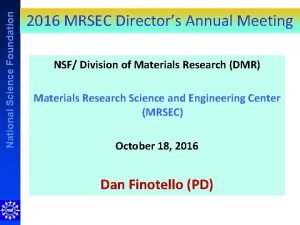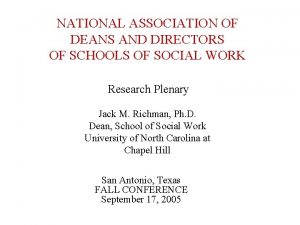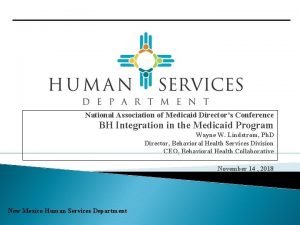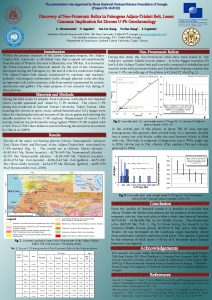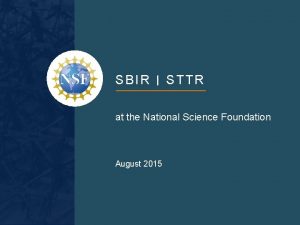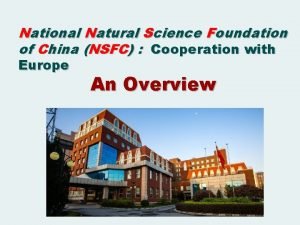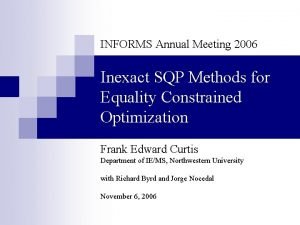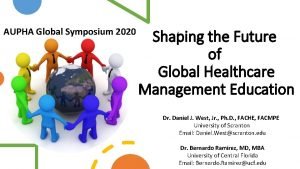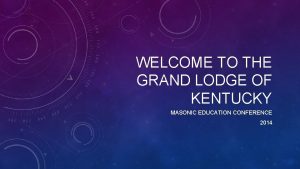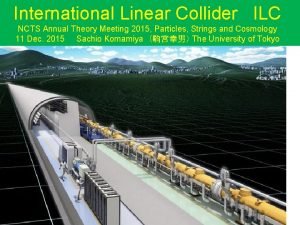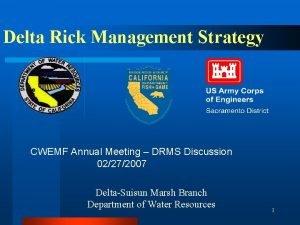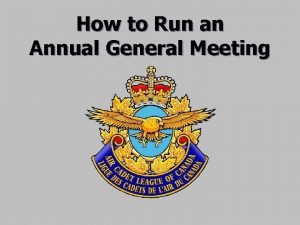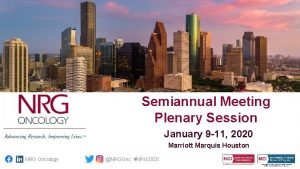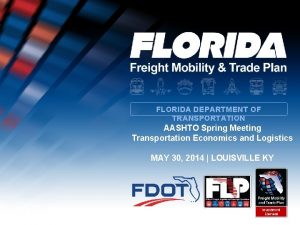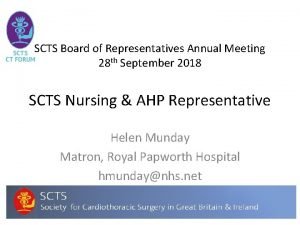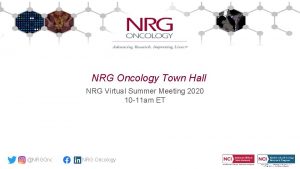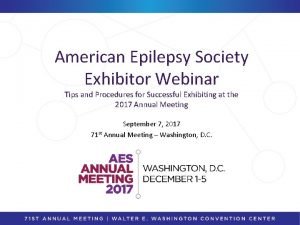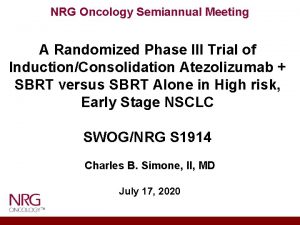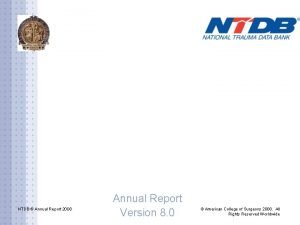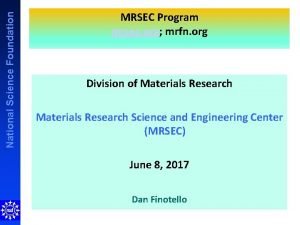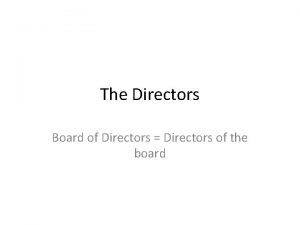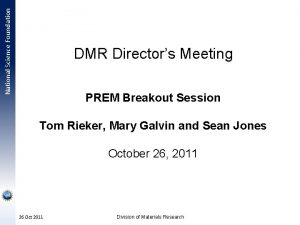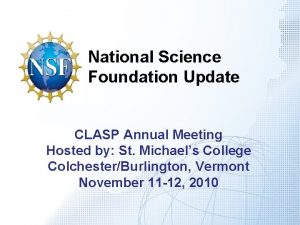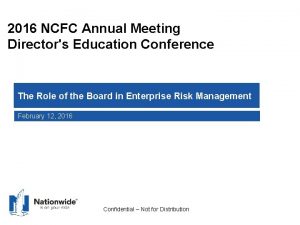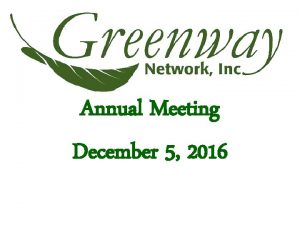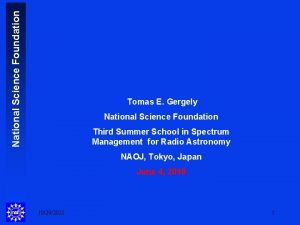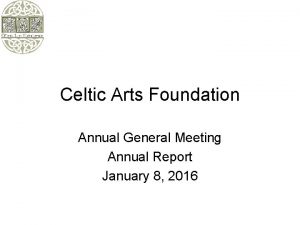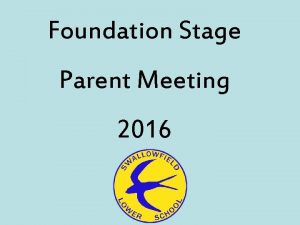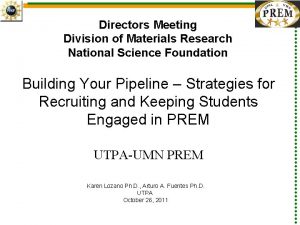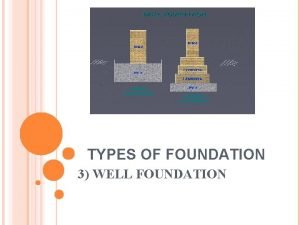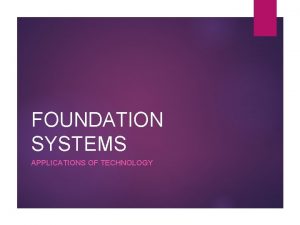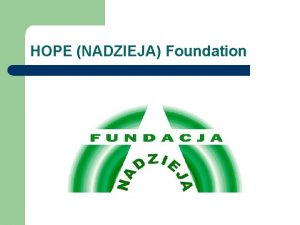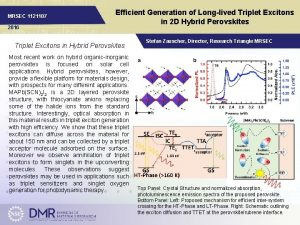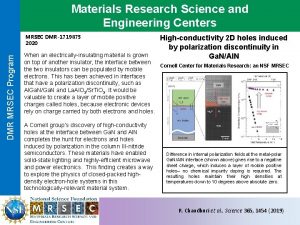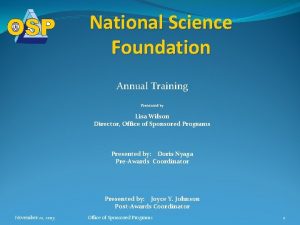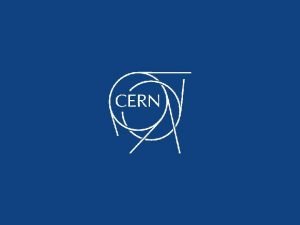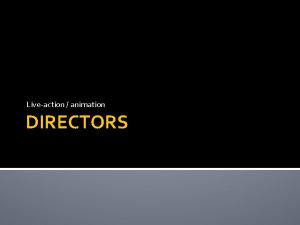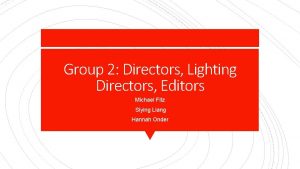National Science Foundation 2016 MRSEC Directors Annual Meeting

























- Slides: 25

National Science Foundation 2016 MRSEC Director’s Annual Meeting NSF/ Division of Materials Research (DMR) Materials Research Science and Engineering Center (MRSEC) October 18, 2016 Dan Finotello (PD)

National Science Foundation 10/15 – 10/16 MRSEC Personnel • A. Caro (Oct. 2015, LANL): Solicitation, Annual Reports, 2 nd Year Site Visits. PD for PREM • M. Deutsch (Jan. 2016, Oregon): MRSEC Competition: Compliance, Panels. PD for EPM • B. Schwenzer (Jul. 2016, PNNL): MRSEC Competition: Compliance, Panels. PD for SSMC • S. Dexheimer (Jul. 2016, Washington State): MRSEC Competition: Compliance, Panels. PD for REU/CMP/DMREF • D. Abhat-Tonse & A. Tonse (April 2016): Web Design & Implementation; mrsec. org, mrfn. org, prem. org, and mips. org? ? Google Statistics hard copy available

National Science Foundation Division of Materials Research (DMR) Administrative Workflow Linda Sapochak, DD Back up: Benita Allison Smith, PS • • Recruitment Mgt. Support Program Budget CGIs IAAs Denese Williams, PA • • • National Facilities Elaine Washington, PS Data Analysis DMR Highlights Refreshment Orders Panel Spreadsheet IAA • • • Designing Materials to Revolutionize and Eng. Our Future XC NIST Guebre Tessema M Back up: Denese Back up: Elaine M I P Charles Ying Materials Research Science & Eng. Centers Back up: Allison Meghan Ackerman, PS Benita Fair, PS • • • John Schlueter • Admin Review Order Supplies Backup Timekeeper Program Budget CGIs • • Electronic & Phonic Materials Daniele Finotello Miriam Deutsch SN M QL DATA Tania Paskova Metals & Metallic Nanostructures REU Sites PREM X C Jose Alfredo Caro Andrew Lovinger W CI NS QL XC Aubrie Ten. Eyck, Contractor • • • Program Budget CGIs IAAs Record Retirement • • • Lynnette Madsen Joseph Akkara Solid-State & Materials Chemistry Paul Sokol X C QL Susan PA Student • • • Program Budget CGIs IAAs • • COV IT Support Data Analysis Trainer XC NAN O DMR Initiatives Alex Simonian IN T XC Birgit Schwenzer X C Eugene Zubarev Claudia Johnson, Contractor Program Budget CGIs IAAs Record Retirement Vacant Ceramics Biomaterials Tomasz Durakiewicz SN M Diana Farkas Admin Review Timekeeper Order Supplies IAA Program Budget CGIs Equip. Excess Polymers Alex Klironomos Condensed Matter Physics X C QL Susan • • Back up: Aubrie Back up: Claudia Renee Ivey, PS CI F 21 Daryl Hess Neila Odom-Jefferson, OS Back up: Meghan Admin Review Technology Trainer Web Updates Listserv Outreach INFE S Birgit Schwenzer Velma Lawson, PSM Condensed Matter & Materials Theory BS F XC X C QL Leonard Spinu DMR Front Desk Support Back up: Renee ICorps Susan Dexheimer M R I Admin Review DMR Highlights Outreach Program Budget CGIs Sean L. Jones, ADDD Expert Juan Nino Freddy Khoury Supports DMR-wide BSF - Binational Science Foundation CIF 21 - Cyberinfrastructure Framework 21 st INFEWS - Innovation at the Nexus of Food, Energy, and Water I-Corps - Innovation Corps INT - International QL - Quantum Leap MIP - Materials Innovation Platforms MRI - Major Research Instrumentation NANO - Nanotechnology NIST - National Institute of Standards & Created by: Velma Lawson, Sept. 9, 2016 Technology NSCI - National Strategic

National Science Foundation 10/15 – 10/16 MRSEC Year Review • 2 nd Year Site Visits (Class of 2014): 12 visits from March 10 to May 18: D. Finotello and A. Caro • Supplements: Outreach/Recruiting; Science Communication; Students w Disabilities • Annual/Final Reports (~30): DF and AC • 2016 MRSEC Competition Solicitation ( A. Caro, C. Ying and L. Sapochak): Published March 1, 2016.

National Science Foundation MRSEC History • 1960 -61 - Interdisciplinary Research Labs (IDLs) -ARPA • 1971 - Proposal to transfer IDLs to NSF as a result of the Mansfield Amendment • 1972 - NSF establishes DMR, MRL program • 1984 - DMR establishes MRG program • 1994 - DMR establishes MRSEC program • 2005 - DMR requests a study of the MRSEC program by the National Academies • 2010 - DMR establishes CEMRI (2+ IRGs) and MIRT programs • 2013 - DMR drops CEMRI/MIRT nomenclature and returns program name back to MRSEC with no small group competition and no 1 IRG MRSEC; 2 – 5 IRGs. • 2016 – MRSEC: 2 -3 IRGs.

National Science Foundation MRSEC & Other NSF Centers 2011 CEMRI/MIRT 2014 IDL/MRL University Year Initiated Cornell 1960 Pennsylvania 1960 Northwestern 1960 Chicago 1961 Harvard 1961 MIT 1961 Pennsylvania State 1974 Ohio State 1982

National Science Foundation MRSEC Program Goals / Achievements • No dept. boundaries: Stimulate and support outstanding interdisciplinary research and education in materials of a scope and complexity that requires a center. All students, in or out of MRSEC benefit from it. • Critical mass of investigators of complementary/diverse expertise • Address fundamental, complex materials problems that are intellectually challenging and important to society • Foster partnerships between academia and industry, National labs, and international • Broadening participation (PREM); Outreach • Re-competition model and Seed program provide a mechanism for a reinvention and adaptation to address emerging areas (flexibility) • Leveraging of funds; Attract faculty • Materials Network Facilities Network, mrfn. org

National Science Foundation Interdisciplinary Research Groups (IRG): Core Unit • Each IRG: – Addresses a major materials topic or area synergistically – Is more than a ‘collection of individual investigators’ – Typical IRG effort includes synthesis, theory, characterization, evaluation, and maybe applications – IRGs map onto Individual Investigator Programs; MRSEC may contain dissimilar IRGs: a unique center feature. • Interaction within an IRG is critical; Interaction among IRGs not required. • Collectively, the MRSEC IRG topics cover the entire research breadth that DMR addresses as a division

• Six year awards, $56 M total in 2014/15/16; Individual Center support from $1. 6 M to $3. 53 M (FY 14 includes i. Super. Seed) • Annual PI meetings (October 18, 2016) • Program Director “only” Site Visit in year 2 (12 in 2016) • Site visit review with a panel of experts during year 4 (12 Site Visits planned in Mar. – Jun. 2018) • Existing MRSEC compete with new proposals in open competition • Education Directors Meeting 11/2/2016 U Penn $63. 0 $53. 0 $43. 0 $33. 0 $23. 0 MRSEC awards + supplements $13. 0 $3. 0 FY 01 FY 02 FY 03 FY 04 FY 05 FY 06 FY 07 FY 08 FY 09 FY 10 FY 11 FY 14 FY 17 $M National Science Foundation MRSEC Awards Features

National Science Foundation MRSEC Expenditures 2016 % of Fixed Total Budget, $56 M/yr 5. 1 12. 9 1. 3 61. 1 9. 2 10. 4 IRGs Industry Seeds Shared Facilities Education Administration Majority of Research funds (IRGs + Seeds) pay for Graduate student and Post-doc salaries.

National Science Foundation 2016 MRSEC Supplement Support • He 4 Recovery Systems (DMR allocates $1 M per year): $300, 000 • Webmaster for mrsec. org, mrfn. org, prem. org, mips. org: $25, 000 • Science Slam/Students w Disabilities/Lo. M/Recruiting: $149, 000 • Total 2016 MRSEC Investment: $56, 474, 000

National Science Foundation High Impact 21 MRSECs (2016) • 56 IRGs • 926 publications (42% 2+ authors)(range 20% - 56%) • 49 patents awarded (the yearly ave. ) 21 MRSEC (2016) 796 (608) supported TTF participants (21 -27%F; 8 -10%URM); 28% PHY, 21. 5% CHE, 17. 7% MS, 10. 3% each EE & CE • 836 GS (25. 1% F, 7. 7% URM)+ 180 UGS (46% F, 16% URM) • 298 Post-docs (24. 8% F, 7. 7% URM)

National Science Foundation Education Outreach, Developing a Diverse Workforce (2016) Extensive Education Programs (21 MRSEC) MRSEC REU (250), RET (56) 900, 000’s impacted K-12+ outreach Broadening Participation Diversity Strategic Plan PREM: Currently 12 Extensive Ind. Collaborations A (1380); NL (114); Ind. (318); Int. (150) Building a National Network Education Coordinators Network Materials Research Facilities Network

National Science Foundation MRFN Statistics 23 centers 1141 instruments 255 experts Recently added instruments Thermogravimetric Analyzer Mass Spectrometer Infrastructure mrfn. org >1140 Instruments Yearly Users of MRSEC Facilities > 1380 Academic > 530 Industry >50 National Labs 743 Publications acknowledged MRSEC SF • 75 MRSEC Technical Staff in SEFs • 31 Other Technicians • 51 Administrative Staff • 37 Education Staff

MRSEC Startup Companies 14 12 10 8 6 4 2 0 1996 1997 1998 1999 2000 2001 2002 2003 2004 2005 2006 2007 2008 2009 2010 2011 2012 2013 2014 2015 2016 National Science Foundation Innovation Since 1985: 146 companies in 22 states plus 3 abroad employing > 2520 individuals. More than 1500 patents awarded

National Science Foundation 2016 2 nd Year Site Visits to Class of 2014 Awardees • 12 Site Visits took place from March 10 - May 16, 2016 Agenda • 8: 30 – 9: 00 Informal Meeting NSF PDs & MRSEC Director • 9: 00 – 9: 05 Introductions • 9: 05 - 10: 00 am: Overview of the MRSEC by the Director • 10 -10: 15 am Coffee Break • 10: 15 – 11: 20 IRGs & SEEDs • 11: 20 – 11: 50 Education & Outreach • 12: 00 -1: 05 pm – Lunch with MRSEC students and post-docs • 1: 15 -2: 15 pm - Shared Experimental Facilities Tour • 2: 15 -3: 00 pm – NSF Panel caucus • 3: 00 – 3: 30 – NSF PDs debrief MRSEC Executive Committee Potential Changes: Informal Meeting replaced with Panel Orientation Replace Tour with Poster Session Add Panel only Meeting after IRGs/Seeds presentation Report mostly on IRGs and Seeds Submit Comments

National Science Foundation Post Award Management: Site Visits 2018 Site Visits • 4 th Year Site Visits with Full Panel, Class of 2014: March to June 2017; 2 days 5 -8 panelists + 1 -2 NSF Program Directors – Report Written/Completed on site; Response to Site Visit Report (SVR) – SVR shared with Reviewers at 2019 MRSEC Competition Reverse Site Visit

National Science Foundation 2016 – 2019 Annual Report Guidelines Hard Copies Available Final Report = Last Annual Report = 12 months timeframe; NOT CUMULATIVE May 2016: 2016 -2019 Submitted for Public Comment July 2016: Submitted to OMB for Approval September 2016: OMB approved them as submitted Changes: Clarified Language and Definitions; New Highlights Template; 508 Public Law

National Science Foundation 2016 MRSEC Competition Solicitation Published: March, 2016 Pre-Proposals Due Date: July 1, 2016 Panels evaluate IRGs Panels: 7 panels, September 7 – 30, 2016 Full Proposal Invitations: emailed October 6, 2016 Full Proposals Due Date: December 2, 2016 Mail Review Reverse Site Visits: Invitations: Mid March 2017 Panels: Mid April to Mid May 2017 To DGA: First week in June

National Science Foundation 2016 MRSEC Solicitation / 2015 COV MRSEC Remarks www. nsf. gov/mps/advisory/covdocs/2015_DMR_COV_Report. pdf • The MRSEC program was viewed as an outstanding example of a program that defines and advances frontier topics in basic materials science, and closely couples such basic discovery with innovations that address societal needs. • The COV is deeply concerned regarding the sizes of awards. The sizes of awards have not kept pace with inflation or the increasing cost of supporting graduate students and, consequently, the buying power of the funds flowing to individual research groups from DMR grants (in single investigator grants as well as MRSEC grants) has eroded to the point that, in some cases, they do not permit full support of even a single graduate student. It was also commented that the buying power of awards has diminished to the point where most graduate students are partially supported on multiple grants. • The COV found a number of instances where comments from reviewers are directed more toward the reputation and visibility of the PIs rather than toward the proposed research. • The COV encourages DMR to consider exploring ways to level the playing field for new MRSEC proposals while maintaining the highest quality scientific standards and expectations on broader impact. • Specific to the MRSEC, the role of seed/superseed projects was viewed by the COV as extremely important to maintaining the cutting-edge position of these centers. It was felt that an increase in the budget of seed programs in MRSECs would help promote further the evolution of the centers and their ability to response to emerging materials research challenges. • Strategic planning in the MRSEC program office should help guide the portfolio development.

National Science Foundation 2015 MRSEC i. Super. SEED Supplements: 2017? The Materials Research Science and Engineering Center program of the Division of Materials Research is making available, depending on funds availability, 3 -4 i. Super. SEEDs. The i. Super. SEED topics of interest must be part of the DMR research portfolio of interest, and for this call they are: Topological Insulators. Theory leading experiment efforts focusing on but not limited to dichalcogenides, Majorana fermions, Weyl semi metals are welcome topics. Quantum Information Science. Topics may include (but not limited to) developing materials, techniques and classical simulation methods for controlled evolution of quantum mechanical states of multiple to many qubit systems utilizing existing qubit technologies, such as quantum dots, superconducting qubits (e. g. transmons and fluxonium), nitrogen vacancy centers, optically-active defects (color centers), quantum cavities, nanomechanical qubits and hybrid qubits BRAIN-related studies (see Alivisatos et al. , Nanotools for Neuroscience and Brain, VOL. 7, # 3, 1850– 1866 (2013), www. acsnano. org, for definitions and appropriate research topics) Sustainable Materials (see DMR DCL NSF 14 -077) 4 funded at $250, 000 each

National Science Foundation 2007 NRC Report on the MRSEC Program https: //www. nap. edu/catalog/11966/the-national-science-foundationsmaterials-research-science-and-engineering-centers-program “The MRSEC program produces excellent, frontier science of the same high standard as that supported by NSF through other mechanisms. ” (but) “The effectiveness of MRSECs has been reduced in recent years by increasing requirements without a commensurate increase in resources. Increasing the mean grant size is necessary to allow the program to fulfill its important mission goals. ”

National Science Foundation 2016 MRSEC Prel. Prop. Competition • Topics were sought that solve fundamental, timely and complex materials problems that are intellectually challenging, important to society, and that potentially broaden the current portfolio. • Topics to expand the MRSEC research portfolio were noted in the Solicitation as per COV comments (1 st time). • Preliminary proposals reviewed based on the IRGs research topics, thus the IRGs in a MRSEC proposal may be reviewed by different panels. Most reviewed in at least 2 panels • 7 panels based on research topics.

National Science Foundation 2016 MRSEC Competition: Review Process Preliminary Proposals: Onsite Panel Review; 7 Topical Panels Panel A: Panel B: Panel C: Panel D: Panel E: Panel F: Panel G: 9/7 - 8/2016 9/12 -13/2016 9/15 -16/2016 9/19 -20/2016 9/22 -23/2016 9/26 -27/2016 9/29 -30/2016

National Science Foundation Summary 2016 MRSEC Competition <$21 M available for awards • The review process involved 89 onsite panelists; these included 24 female, 5 from underrepresented groups, 2 from national labs and 1 person with disabilities. • An additional 11 ad-hoc mail reviewers provided 15 IRG reviews, which complemented the panelists' reviews. • A total 885 reviews were submitted corresponding to an average of 4. 3 reviews per IRG. • Decisions: IRG Invite or Not Invite IRGs.
 Mrsec science slam
Mrsec science slam National association of deans and directors
National association of deans and directors National association of state medicaid directors
National association of state medicaid directors Shota rustaveli national science foundation
Shota rustaveli national science foundation Nsf sbir deadlines
Nsf sbir deadlines Nsfc
Nsfc Informs annual meeting
Informs annual meeting Aupha annual meeting
Aupha annual meeting American psychiatric association annual meeting 2020
American psychiatric association annual meeting 2020 Grand lodge kentucky
Grand lodge kentucky Positron vs proton
Positron vs proton Cwemf
Cwemf How to run an annual general meeting
How to run an annual general meeting Nrg oncology meeting 2017
Nrg oncology meeting 2017 Aashto annual meeting 2015
Aashto annual meeting 2015 Scts membership
Scts membership Nrg oncology semi annual meeting 2018
Nrg oncology semi annual meeting 2018 American epilepsy society annual meeting 2017
American epilepsy society annual meeting 2017 Nrg oncology meeting 2016
Nrg oncology meeting 2016 My favorite subject is art
My favorite subject is art National trauma data bank annual report 2020
National trauma data bank annual report 2020 Pile foundation details
Pile foundation details Foundation standard 1 academic foundation
Foundation standard 1 academic foundation For today's meeting
For today's meeting Proposal kickoff meeting agenda
Proposal kickoff meeting agenda What is meeting and types of meeting
What is meeting and types of meeting
